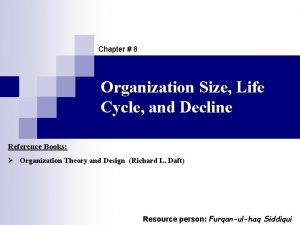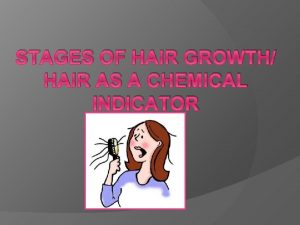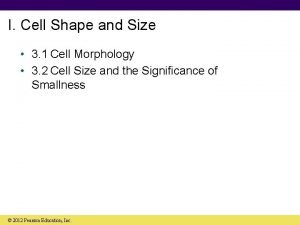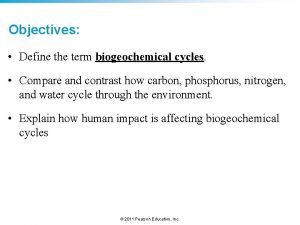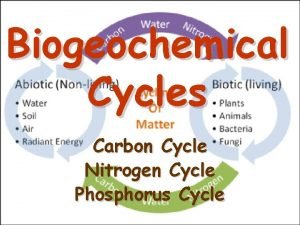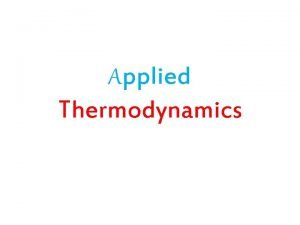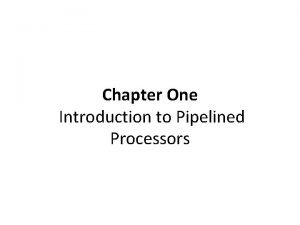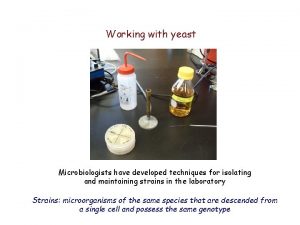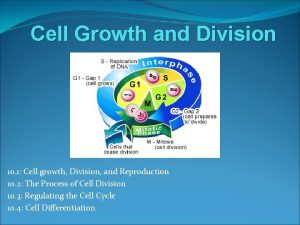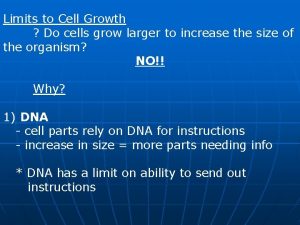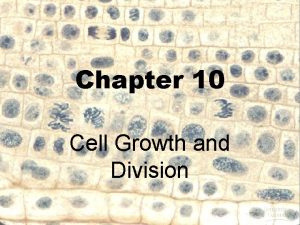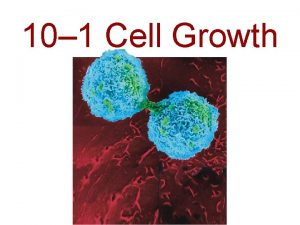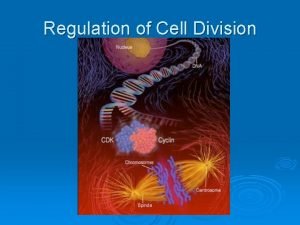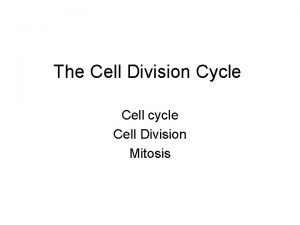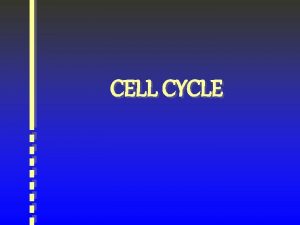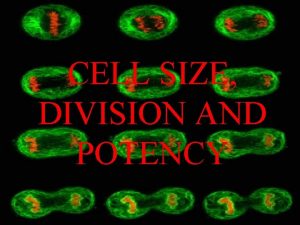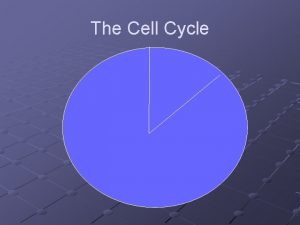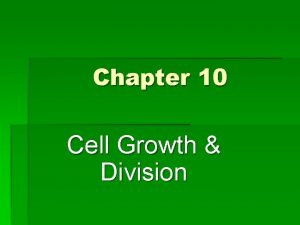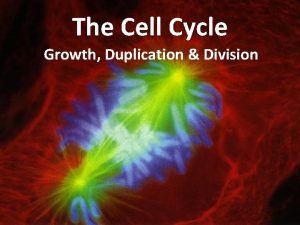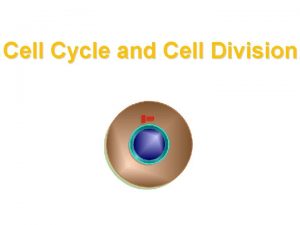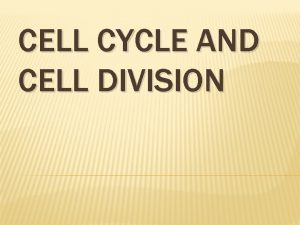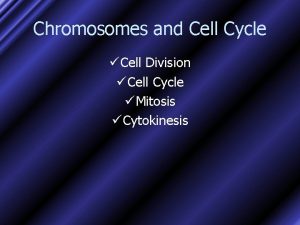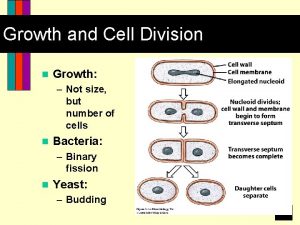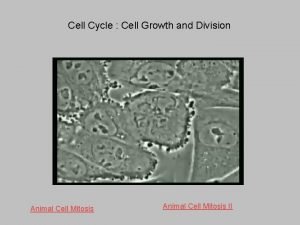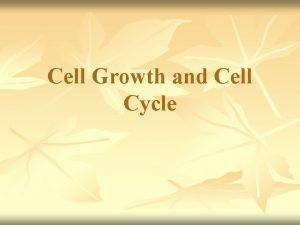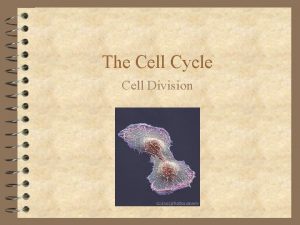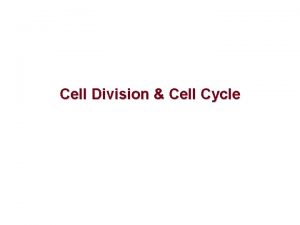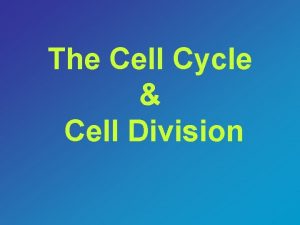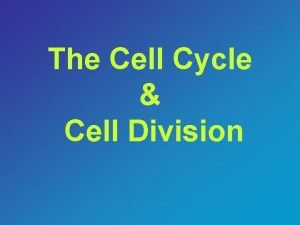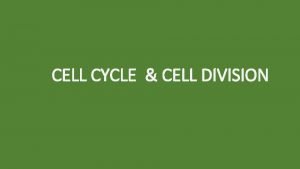Cell Growth and Division Cell Size Cell Cycle







































- Slides: 39

Cell Growth and Division Cell Size Cell Cycle Mitosis

Why do Cells Divide? Cellular Reasons 1. The DNA is placed under too much stress 2. Movement of water and nutrients is not efficient in larger cells Organism Reasons 1. Replace Dead or Damaged Cells 2. Growth of a multicellular organism 3. Reproduction of a Unicellular Organism

Cell Size

Factors that determine cell size • Surface Area- the amount of cell membrane • Volume- the space the inside of the cell takes up • Healthy cells have a high surface area: volume ratio

Surface Area : Volume Ratio • Calculate the surface area : volume ratio for each example • Determine which ratio is the best of a cell? Explain your answer • The largest cell is an ostrich egg (the size of a grapefruit) How does it survive?

What next? • If a cell grows too big what happens? – IT DIVIDES, HOW IS CELL DIVISION HELPFUL? – IT allows for a better surface area : volume ratio

Cell Division • Asexual Reproduction of offspring that are identical to the parent • Sexual Reproduction of offspring that are different from the parent cells.

Terms of Cell Division • Chromosome – Chromatid – Centromere – Kinetochore • Daughter cell/Sister cells • Parent cell

Chromosomes • When cells are ready to divide they need to pack their DNA • Unpacked DNA is call chromatin • Packed DNA is call a chromosome

Chromosome structure chromatin loop scaffold protein nm 30 rosettes of chromatin loops chromosome DNA nucleosome histone DNA double helix

Kinetochore • Each chromatid has own kinetochore proteins – microtubules attach to kinetochore proteins

Mitotic Chromosome § Duplicated chromosome 2 sister chromatids u narrow at centromeres u contain identical copies of original DNA u homologous chromosomes single-stranded sister chromatids double-stranded homologous = “same information”

Cell Cycle G 1 - The cell grows and increases in size S- Synthesis- copying of DNA G 2 - Cell prepares to divide, it does not increase in size M- Mitosis/Nuclear Division of chromosomes C- Cytokinesis- Division of the cytoplasm

Interphase • 90% of cell life cycle – cell doing its “everyday job” • produce RNA, synthesize proteins/enzymes – prepares for duplication if triggered I’m working here! Time to divide & multiply!

Cell cycle • Cell has a “life cycle” cell is formed from a mitotic division cell grows & matures to divide again G 1, S, G 2, M epithelial cells, blood cells, stem cells cell grows & matures to never divide again liver cells G 1 G 0 brain / nerve cells muscle cells

Mitosis • Events of mitosis: – Prophase – Metaphase – Anaphase – Telophase Words to know: centrioles, spindle fibers, nuclear envelope

Phases of Mitosis Prophase • Chromatin condenses (packs) to form chromosomes • Centrioles move to opposite poles (ends of the cell) and spindle fibers begin to form between them and stretch the length of the cell • Nuclear envelope begins to breakdown and disappear • Nucleolus disappears

Phases of Mitosis Metaphase • Spindle fibers connect to each chromosome at the centromere/kinetochore • The spindle fibers move the chromosomes to the center (middle) of the cell • All chromosomes line the center of the cell. • 46 for humans

Phases of Mitosis Anaphase • The sister chromatids separate into individual chromosomes and move apart • Away, Away

Phases of Mitosis Telophase • Chromosomes gather at opposite ends of the cell • Chromosomes unpack (uncoil) • TWO new nuclear envelopes reform • Spindle fibers break down • Nucleolus reappears

Cytokinesis • Cytoplasm pinches in half. • Each new daughter cell has a set of chromosomes, cytoplasm and organelles

Cytokinesis Animal Cell Plant Cell • Cleavage furrow • Cell plate

Cytokinesis in plant cell

Products of Mitosis • 2 Identical Diploid Cells • Somatic Cells (Body Cells) • Daughter Cells

Mitosis in whitefish blastula

onion root tip

Checkpoint control system § Checkpoints – cell cycle controlled by STOP & GO chemical signals at critical points – signals indicate if key cellular processes have been completed correctly

Checkpoint control system § 3 major checkpoints: • G/S § can DNA synthesis begin? • G 2/M § has DNA synthesis been completed correctly? § commitment to mitosis • spindle checkpoint § are all chromosomes attached to spindle? § can sister chromatids separate correctly?

G 1/S checkpoint • G 1/S checkpoint is most critical – primary decision point • “restriction point” – if cell receives “GO” signal, it divides • internal signals: cell growth (size), cell nutrition • external signals: “growth factors” – if cell does not receive signal, it exits cycle & switches to G 0 phase • non-dividing, working state

Activation of cell division § How do cells know when to divide? § cell communication signals § chemical signals in cytoplasm give cue § signals usually mean proteins w activators w inhibitors experimental evidence: Can you explain this?

External signals • Growth factors – coordination between cells – protein signals released by body cells that stimulate other cells to divide • density-dependent inhibition – crowded cells stop dividing – each cell binds a bit of growth factor » not enough activator left to trigger division in any one cell • anchorage dependence – to divide cells must be attached to a substrate » “touch sensor” receptors

Growth Factors and Cancer • Growth factors can create cancers – proto-oncogenes • normally activates cell division – growth factor genes – become oncogenes (cancer-causing) when mutated • if switched “ON” can cause cancer • example: RAS (activates cyclins) – tumor-suppressor genes • normally inhibits cell division • if switched “OFF” can cause cancer • example: p 53

Cancer & Cell Growth § Cancer is essentially a failure of cell division control uunrestrained, uncontrolled cell growth § What control is lost? ulose checkpoint stops ugene p 53 plays a key role in G 1/S restriction point p 53 is the Cell Cycle Enforcer § p 53 protein halts cell division if it detects damaged DNA w options: n stimulates repair enzymes to fix DNA n forces cell into G 0 resting stage n keeps cell in G 1 arrest n causes apoptosis of damaged cell § ALL cancers have to shut down p 53 activity p 53 discovered at Stony Brook by Dr. Arnold Levine

p 53 — master regulator gene NORMAL p 53 allows cells with repaired DNA to divide. p 53 protein DNA repair enzyme p 53 protein Step 1 Step 2 Step 3 DNA damage is caused by heat, radiation, or chemicals. Cell division stops, and p 53 triggers enzymes to repair damaged region. p 53 triggers the destruction of cells damaged beyond repair. ABNORMAL p 53 abnormal p 53 protein Step 1 Step 2 DNA damage is caused by heat, radiation, or chemicals. The p 53 protein fails to stop cell division and repair DNA. Cell divides without repair to damaged DNA. cancer cell Step 3 Damaged cells continue to divide. If other damage accumulates, the cell can turn cancerous.

Development of Cancer • Cancer develops only after a cell experiences ~6 key mutations (“hits”) – unlimited growth • turn on growth promoter genes – ignore checkpoints • turn off tumor suppressor genes (p 53) – escape apoptosis • turn off suicide genes – immortality = unlimited divisions • turn on chromosome maintenance genes – promotes blood vessel growth • turn on blood vessel growth genes – overcome anchor & density dependence • turn off touch-sensor gene It’s like an out-of-control car with many systems failing!

What causes these “hits”? § Mutations in cells can be triggered by u u UV radiation chemical exposure radiation exposure heat u u cigarette smoke pollution age genetics

Tumors § Mass of abnormal cells u. Benign tumor § abnormal cells remain at original site as a lump w p 53 has halted cell divisions § most do not cause serious problems & can be removed by surgery u. Malignant tumor § cells leave original site w lose attachment to nearby cells w carried by blood & lymph system to other tissues w start more tumors = metastasis § impair functions of organs throughout body

Traditional treatments for cancers § Treatments target rapidly dividing cells u high-energy radiation § kills rapidly dividing cells u chemotherapy § stop DNA replication § stop mitosis & cytokinesis § stop blood vessel growth

New “miracle drugs” § Drugs targeting proteins (enzymes) found only in cancer cells u. Gleevec § treatment for adult leukemia (CML) & stomach cancer (GIST) § 1 st successful drug targeting only cancer cells without Gleevec Novartes with Gleevec
 Section 10-2 cell division
Section 10-2 cell division Cell cycle and cell division
Cell cycle and cell division Phases of cell cycle
Phases of cell cycle Chapter 8 cell growth and division section 8-2 answer key
Chapter 8 cell growth and division section 8-2 answer key Cell growth division and reproduction
Cell growth division and reproduction Define growth analysis
Define growth analysis Pith
Pith Primary growth and secondary growth in plants
Primary growth and secondary growth in plants Primary growth and secondary growth in plants
Primary growth and secondary growth in plants 369 times 2
369 times 2 Long division repeated subtraction
Long division repeated subtraction Long division vs synthetic division
Long division vs synthetic division Sunthetic division
Sunthetic division Step growth polymerization vs chain growth
Step growth polymerization vs chain growth Geometric vs exponential growth
Geometric vs exponential growth Neoclassical growth theory vs. endogenous growth theory
Neoclassical growth theory vs. endogenous growth theory Organic vs inorganic growth
Organic vs inorganic growth![Const int size=18; string *tb12 = new string[size]; Const int size=18; string *tb12 = new string[size];](data:image/svg+xml,%3Csvg%20xmlns=%22http://www.w3.org/2000/svg%22%20viewBox=%220%200%20200%20200%22%3E%3C/svg%3E) Const int size=18; string *tb12 = new string[size];
Const int size=18; string *tb12 = new string[size]; Side separation can be used
Side separation can be used Biology.arizona.edu/cell bio/activities/cell cycle/01.html
Biology.arizona.edu/cell bio/activities/cell cycle/01.html Organizational decline stages
Organizational decline stages Mitosis and meiosis
Mitosis and meiosis Chromosome parts
Chromosome parts Mitosis
Mitosis Pubic hair growth cycle
Pubic hair growth cycle Cell shape and size
Cell shape and size Significance of biogeochemical cycle
Significance of biogeochemical cycle Difference between phosphorus cycle and carbon cycle
Difference between phosphorus cycle and carbon cycle Difference between open cycle and closed cycle gas turbine
Difference between open cycle and closed cycle gas turbine Reservation table in computer architecture
Reservation table in computer architecture Chapter 5 two-cycle and four-cycle engines answers
Chapter 5 two-cycle and four-cycle engines answers Mhd power generation ppt
Mhd power generation ppt Yeast cell growth curve
Yeast cell growth curve 10-1 cell growth
10-1 cell growth Limits to cell growth
Limits to cell growth Section 10-1 cell growth
Section 10-1 cell growth Limits to cell growth
Limits to cell growth Pmat
Pmat Frequency of cell division
Frequency of cell division Mitosis vs meiosis concept map
Mitosis vs meiosis concept map



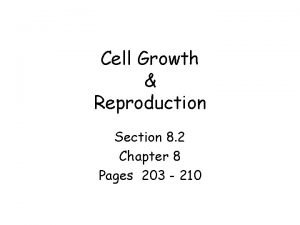
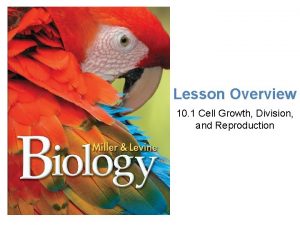












![Const int size=18; string *tb12 = new string[size]; Const int size=18; string *tb12 = new string[size];](https://slidetodoc.com/wp-content/uploads/2020/11/1588947_40cf3415d0afabae1c436a49b39f4ad0-300x225.jpg)


